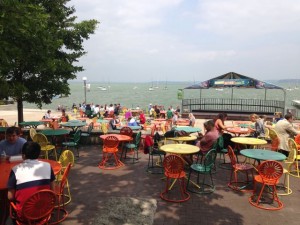Thursday at the Games+Learning+Society Conference was another packed day of speakers, the GLS Showcase and food. It kicked-off with keynote from Brenda Romero, the amazing Fulbright scholar, entrepreneur, artist, writer and games guru. She has been a pioneers in the gaming industry going back to 1981. Listing all of her accolades would take this entire post, but as someone listed in the top ten list of developers by Gamastura.com. He a high-energy, funny and entertaining speaker because that is the person she is – no slick delivery, just oozing enthusiasm (and F-bombs) with everything she says. Her topics was “Women in Gaming”, and as you may have surmised by my description of her, this is not the way she identifies herself, despite the fact that she keeps getting awards to this effect. She shot holes in the division the industry and media have drawn based on sex. If living those issues every day isn’t annoying enough, she is also married to gaming sensei John Romero of Wolfenstein 3D, DOOM, Quake fame, so she has to constantly deflect questions about him.
My first session of the morning was the presentation of three papers on the subject of narrative. I am particularly interested in this topic because this was the framework from which I authored my ARIS game, Dilemma 1944. Stephen Slota of the University of Connecticut discussed the role of narrative as a means to explore a game setting in his paper, Stories, Games & Learning Through Play: An Analysis of Narrative Affordances in Game-Based Instruction. He used Project Technologia to demonstrate collaborative storytelling emphasizing how users can experience context, chronology and content in a manner that is not dominated by achievement. Next, Sean Duncan of Indiana University presented “I Have To Tell You Something”: How Narrative and Pretend Play Intersect In Story Games. He discussed how board games like Fiasco allow players to embody different identities and the roles that come with them through imaginative play. Finally, James Cox presented a means to provide direction and options in games through narrative versus drop-down menus or information panels in Metafiction in Videogames. He described “the fourth wall” concept from Greek theatre, where a character steps away from the play and speaks directly to the audience. He identifies four levels of metafictions: emergent (fictions revealed to the players), immersive (fiction that brings the player into the narrative), internal (character-to-character), and external (designer-to-player). All of these papers were very thought provoking. I’m looking forward to reading through them.
Lunch time features another rant with Jim Gee who entertained us all with his predictably unpredictable zingers. He noodled through many topics all on the theme governmental and economic impact on education and the need for a societal shift in thinking to have any educational change work. He believes that Americans are living in a state that more closely resembles the 1890’s than the 1950’s. His best line of the day: “Liberals keep pitching softball to right wingers.”
My afternoon session focused on landscape and geography, which are topics near and dear to my heart. Landscape architect and professor Christopher Marlow from Ball University presented a fascinating session on how gaming is used by his students to learn important conceptual principles of designing inside and outside common spaces. Students were also given the opportunity to develop their own games for learning. He described his favourite, Sustainability which is based on Plants and Zombies where players have to decide where to place the best water drainage systems. Julie Oltman of Lehigh University demonstrated how ARIS could be used to augment a field trip for grade 3 students.
The last session of the day was my favourite: Collaborative Content Generation. Mark Chen of Pepperdine showed his research on Twine games with disadvantaged youth in Los Angeles. These games are low-tech, choose-yoiur-own-adventure digital narratives. His goal was to give a voice to the participants through play, where they collect written word, digital photos and hand-drawn pictures etc. Anthony Betrus, Nate Turcotte an Matt Leifeld demonstrated the simple card game, Teaching Bad Apples which they designed for Pre-Service teacher education. We all played in the session and had a blast. Players are given 2 cards with different response options that teachers may have in a given situation. Next a situation card is drawn and players must apply their card. Of course the options are almost always humorous but act as a spring board for a deeper conversation of that scenario. David Ng of the Michael Smith Lab at UBC finished up with Phylo. This game leverages crowd sourcing to create trading cards games that foster learning in any domain. He uses biodiversity cards that were ultimately adopted and produced by the Beatty Biodiversity Museum at UBC. Check out his project at phylogame.org.
It was a warm and beautiful night overlooking the Terrace at Memorial Union. Once again we were spoiled with delicious food an beer. I’m not sure how I’m going to source Leinenkugal Shady in Vancouver.


